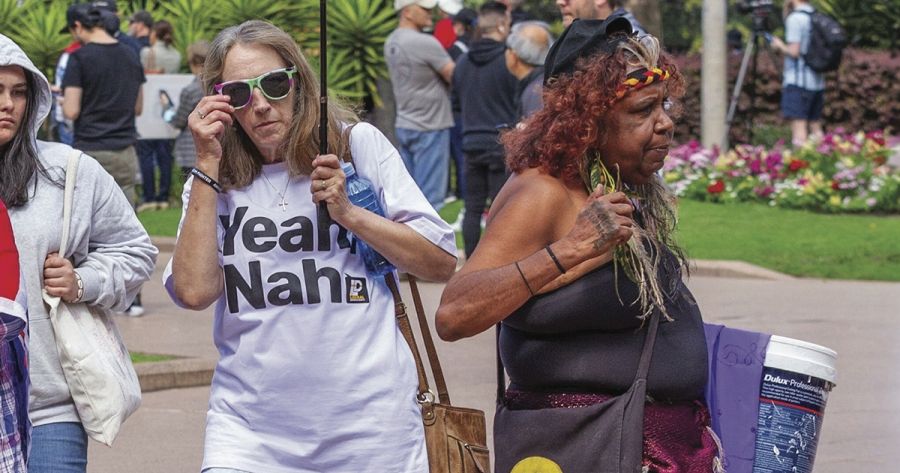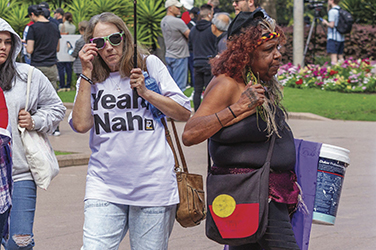
- Free Article: No
- Contents Category: Commentary
- Custom Article Title: Voiceless in Australia
- Review Article: Yes
- Article Title: Voiceless in Australia
- Article Subtitle: Will we ever have another referendum?
- Online Only: No
- Custom Highlight Text:
Do you know whether Aboriginal and Torres Strait Islander peoples are recognised in your state Constitution? If you responded with a mental shrug and a muttered ‘No idea’, then you would fall within the vast majority. In fact, from 2004 to 2016, each Australian state amended its Constitution to insert recognition of their Indigenous peoples. Yet the effect has been negligible and hardly anyone knows it happened. Why?
- Featured Image (400px * 250px):

- Alt Tag (Featured Image): Anne Twomey on the future of the Voice to Parliament
So now we have constitutional recognition of Indigenous Australians across every state in the nation, which is largely unknown and ineffective, while a referendum to achieve constitutional recognition and facilitate practical reform at the national level was heavily defeated. The key to this story is the referendum. The absence of one at the state level undermined the recognition granted, showing the political importance of the referendum. Yet the requirement for one at the national level not only defeated recognition, but damaged the status quo, causing politicians to retreat from previously agreed reform initiatives.
When the referendum was first proposed in 1890 as the means of amending a future Commonwealth Constitution, it was regarded as both radical and conservative. It was a foreign idea – a Swiss mechanism, unknown to Britain or its colonies. Its direct involvement of the common man in constitutional matters was at odds with British tradition. But this radical idea of giving the people the final say on constitutional reform was also seen as inherently conservative in nature. It would allow the people to block what the British constitutionalist A.V. Dicey called ‘the violence of partisanship and the fanaticism of reformers’. Dicey dubbed the referendum ‘the People’s Veto’, which remains apt in Australia.
At the 1891 Constitutional Convention, the then Queensland premier, Sir Samuel Griffith, opposed the use of the referendum for constitutional reform. He considered that a very large proportion of electors would not be sufficiently acquainted with the Constitution to vote upon its adoption or reform, and that such a vote would not represent their genuine deliberation. He preferred the use of conventions comprising experts to deal with such matters. He won over the Convention, and the referendum was cast aside. But at the 1897 Convention, a more democratic spirit prevailed and the referendum was revived by advocates including Alfred Deakin. While the Constitution was to be passed in London by the Westminster Parliament, as an exercise in British parliamentary sovereignty, it was first to be approved by the electors of each Australian colony, as an expression of popular sovereignty. The referendum was to be the ongoing voice of the people on constitutional reform.
In the 1990s, the High Court recognised that the British parliamentary sovereignty which originally underpinned the Commonwealth Constitution had been cast off, as a result of the enactment of the Australia Acts 1986. This left popular sovereignty as the enduring source of the Constitution. It was to be found not only in the original approval of the Constitution, but in the will of the people to uphold the Constitution and their continuing control over its change through a referendum. The referendum is therefore fundamental to the sovereignty of the Australian people. But what happens if the Australian people cease genuine deliberation on referendums? What if the people become unwilling to change the Constitution and leave it frozen in a form of cryopreservation? Is this an abdication of sovereignty?
Voting No in a referendum may, of course, be a genuine deliberative choice and a full exercise of sovereignty. Constitutional proposals may be of poor quality or simply propose changes that the people do not support.
But a No vote can also indicate a failure to engage or a rejection of the responsibility to choose. Where voters do not have strong foundational knowledge about the system of government and the Constitution, there is a risk that they will abdicate their responsibility to make a deliberative choice in a referendum and default to a No vote. This abdication of responsibility was encouraged in the 1999 republic referendum and the 2023 Voice referendum through the insidious slogan ‘Don’t know, vote No’.
Added to this were arguments that the Constitution is a sacred document that should not be touched, and that no constitutional reform should be made, lest the High Court interpret the change to mean something different. All these arguments can be run to oppose any referendum. They encourage the people to lay down their sovereignty and leave constitutional change to the élites. If those arguments are treated by future governments as popularly accepted and unassailable, there is a real chance that no government will risk its political capital by holding a referendum again – at least not unless it has a solid guarantee of bipartisan support, which may still not be enough for success.
How does constitutional change happen without a referendum? The two main ways are through political action and High Court interpretation. For example, politicians can achieve adjustments to the scope of Commonwealth legislative power by entering into treaties, so that parliament can then legislate to give effect to treaty obligations. State parliaments can also refer matters to the Commonwealth Parliament, expanding its legislative powers.
Greater constitutional change has been effected by the High Court’s interpretation of the Constitution. For example, in 1974 and 1988 referendums were held to grant a constitutionally protected universal franchise. Both were defeated. In 2007, the High Court drew an implication from the Constitution that imposed a universal franchise.
In 1911, 1913, 1919, 1926, 1944, and 1946, referendums were held to expand the scope of one or both of the Commonwealth Parliament’s powers in relation to corporations and industrial relations. All of them failed. In 2006, in the WorkChoices Case, the High Court reinterpreted the corporations power so broadly that it overcame all the limitations on the industrial relations power and achieved the changes the failed referendums had sought. When it was argued that such a course would effectively overturn the will of the people, as expressed through referendums, a majority of the Court responded:
[F]ew referendums have succeeded. It is altogether too simple to treat each of those rejections as the informed choice of electors between clearly identified constitutional alternatives. The truth of the matter is much more complex than that. For example, party politics is of no little consequence to the outcome of any referendum proposal. And much may turn upon the way in which the proposal is put and considered in the course of public debate about it.
It is a well-recognised phenomenon that courts in those countries where the people take an active role in constitutional reform are reluctant to engage in significant reform through interpretation. In contrast, where the people abdicate their role and where the Constitution is effectively frozen, courts step in to fill the vacuum and perform the role of updating the Constitution.
So where does this leave us? On the one hand, we have a High Court that recognises that the sovereignty of the Australian people is exercised through their votes in a referendum. Yet, we have also seen the High Court, at least in the past, dismissing votes in failed referendums as uninformed and tainted by party politics.
On the other hand, we saw opponents of the Voice, including politicians, arguing that people should give an uninformed No vote and that it was ‘too risky’ to change the Constitution due to possible perverse High Court interpretation. In doing so, they seemed to be encouraging the people to give up their voices, handing responsibility for constitutional change to those in the very court they demonise.
While the referendum was about giving a Voice to Aboriginal and Torres Strait Islander people, the outcome may be that the Australian people lose their own voice in the exercise of their sovereignty if governments make the pragmatic assessment that there is no point putting referendums in future. If so, we will all have lost something truly precious.
This article is one of a series of ABR commentaries on cultural and political subjects being funded by the Copyright Agency’s Cultural Fund.



Comments powered by CComment